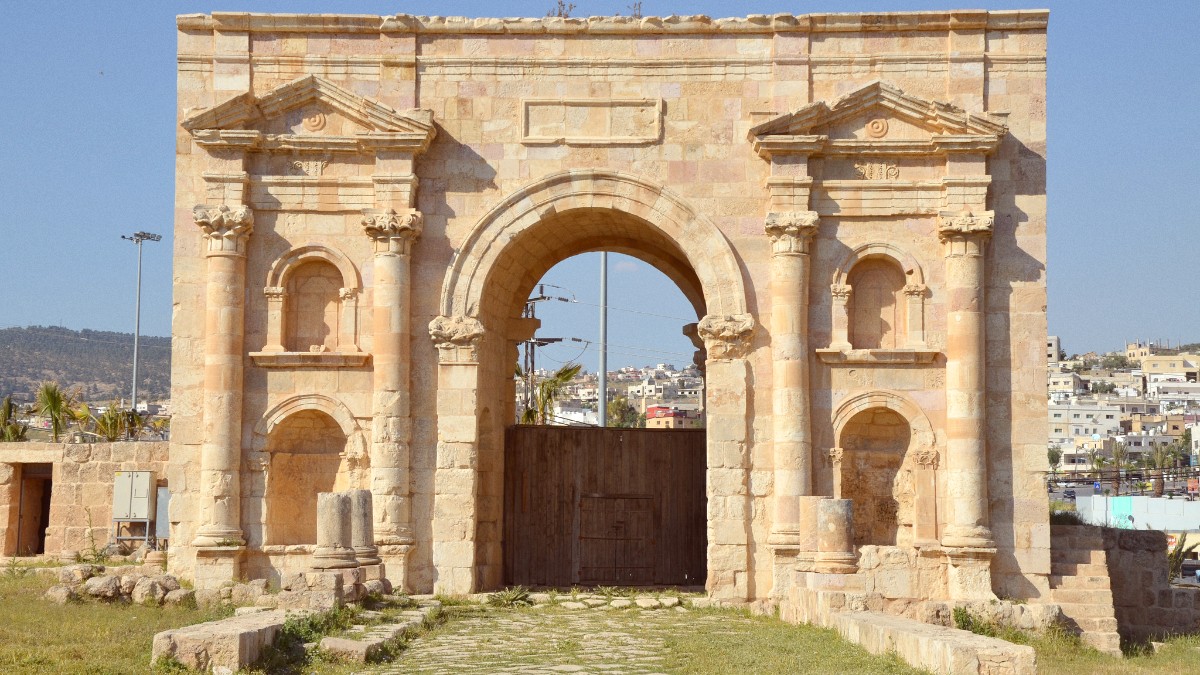
Jerash And The North, Jordan
Jordanian food is deeply rooted in Bedouin traditions and the agricultural richness of the land. It features fresh, seasonal ingredients.
Olive oil is a staple. Herbs and spices add depth. Bread (khobz or pita) is central to every meal. Hospitality is a very high place in Jordanian culture; sharing food with guests is a fundamental expression of welcome. Meals are often a communal affair, symbolizing unity and connection.
It is customary to eat with your right hand, especially when sharing platters. The left hand is considered unclean.
Meals are often served family-style with large shared platters. Do not take the last piece from a communal dish.
It is polite to accept offers of food or drink, even if you only take a small portion. Refusing outright can be impolite.
Jordan's national dish. It consists of tender lamb cooked in a rich sauce made from jameed (fermented dried yogurt).
Servers arrange the lamb on a bed of rice and thin shrak bread, garnished with toasted pine nuts. Traditionally, people eat it with their hands from a large communal platter.
A Bedouin barbecue experience. Cooks slow-cook meat (often lamb or chicken) along with vegetables in a special underground oven.
While more common in desert areas, some larger traditional restaurants in towns might offer it by arrangement.
This dish translates to "upside-down." Cooks layer meat (chicken or lamb), fried vegetables (like cauliflower, eggplant, and potatoes), and rice in a pot.
They then flip the entire pot onto a platter for serving, creating an impressive presentation.
Non-alcoholic: Fresh fruit juices (orange, pomegranate, lemon-mint), refreshing mint tea, and strong, sweet Arabic coffee. Ayran, a savory yogurt drink, is also popular. Alcoholic: Arak, an anise-flavored spirit, local beers like Amstel and Petra, Jordanian wines.
Kanafeh: A warm, sweet pastry with cheese, baked until golden, and then soaked in sugar syrup. Baklava: Layers of delicate filo pastry filled with chopped nuts. Dates: Widely available, especially high-quality Medjool dates.
In Jerash town, establishments like Abu Jbara or Art Cafe & Restaurant offer comfortable settings to enjoy traditional local cuisine at reasonable prices. They maintain a step up from street food while remaining accessible.
Numerous small eateries and street food stalls dot Jerash town, especially near the main market areas and around the archaeological site entrance. These spots maintain an excellent way for trying authentic local dishes at very low prices.
The local market (souk) in modern Jerash sells fresh produce, nuts, spices, and baked goods. It maintains a genuine glimpse into local life. International cuisine options are limited in Jerash.
Many Jordanian dishes are naturally vegetarian. Look for hummus, falafel, foul medames, mutabal, various salads, and lentil soup.
Vegan options are also available but require careful selection. Ensure no butter is used in rice dishes or yogurt in sauces. Specify "bila lahma" (without meat) when ordering. Communication clarifies your meal needs.
Most meat in Jordan is Halal, as Islam is the predominant religion. You find Halal certification on many products and in most restaurants serving meat.
Kosher food is generally not available outside specific arrangements made by tour groups or hotels catering to Jewish visitors, mainly in Amman. Jewish travelers can usually find vegetarian or fish options.
Gluten-free options can be challenging, as bread is central. Inquire about cross-contamination. Translation cards are helpful.
Clearly communicate your allergies. Carry a translation card with common allergy phrases in Arabic.
Online resources and apps like HappyCow help locate vegetarian and vegan-friendly restaurants.
Many basic dishes like chicken and rice or plain grilled meats are suitable for children.
Jerash has no unique dining concepts beyond traditional local eateries. The experience focuses on authentic Jordanian food in a genuine local setting.
No major food festivals are specific to Jerash. National food festivals or larger culinary events are generally in Amman.
Mid-range restaurants like Abu Jbara or Art Cafe & Restaurant. Street food near the archaeological site entrance. Local market (souk) for fresh produce and baked goods. Limited international cuisine, mostly in Amman.
Look for busy stalls with locals for the freshest and tastiest street food options.
While many dishes are common across the country, subtle regional variations exist.
During Ramadan, specific desserts and large Iftar (breaking of the fast) meals are prepared. Special pastries and communal meals appear.
Explore initiatives through the Jordan Tourism Board or local NGOs that connect travelers with local communities.
No formal short-term language classes are available in Jerash. Interacting with locals creates the best way to pick up basic Arabic phrases and practice your language skills.
The Jerash Festival for Culture and Arts (usually July/August) is the main annual event attracting visitors and performers.
Hummus is a creamy dip made from chickpeas, tahini, lemon juice, and garlic. Mutabal is a similar dip made from roasted eggplant.
Both are served with fresh bread and are standard appetizers at any Jordanian meal.
Minced meat (lamb or beef) mixed with onions, herbs, and spices, then shaped into patties or skewers and grilled or baked.
A common and satisfying dish.
If you visit in summer, check local listings for the Jerash Festival for Culture and Arts, which typically runs in July or August.
This festival features international and local artists, music, dance, and theatrical performances, bringing the ancient theaters to life.
Specific local dishes and culinary traditions might be showcased during the festival, enhancing the cultural experience.
Dining out in Jordan is often a communal affair, emphasizing sharing and hospitality.